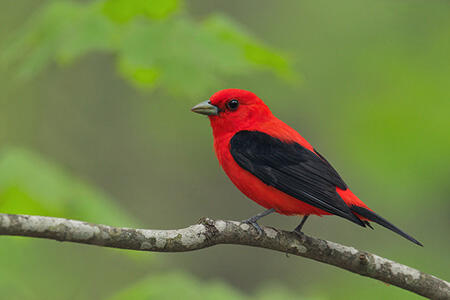- Scientific name: Piranga olivacea
Species of Greatest Conservation Need (MA State Wildlife Action Plan)
Description

Scarlet tanager (Piranga olivacea)
Male scarlet tanagers are bright red with black wings and tail when in breeding plumage. Females, immatures, and males during the fall and winter are dull green above, yellow below, with greenish-gray (female) or black (male) wings. Their song is often likened to that of a robin with a sore throat, and they regularly produce a “chip-burrr” call note. The scarlet tanager is monogamous and highly territorial. During the nesting period, they are primarily insectivorous, gleaning for insects on the wing, but they also forage on fruit during much of the year.
Life cycle and behavior
Scarlet tanagers arrive in Massachusetts in late April to early May and establish breeding territories in mature deciduous and mixed forests. The breeding season extends from May through July, when they construct cup-shaped nests high in the canopy. Females lay 3–5 eggs, which they incubate for about two weeks. Both parents participate in feeding nestlings that fledge after approximately 9–15 days.
Following breeding, tanagers undergo a molt before fall southbound migration. During migration, they may stop in a variety of habitats, including forest edges and early successional habitats, to forage on insects and fruit. They winter primarily in lowland and foothill forests of northern South America.
Population status
Although the scarlet tanager is not listed under the Massachusetts Endangered Species Act, it is experiencing a long-term population decline in Massachusetts, primarily due to habitat loss, fragmentation, and degradation. Data from the North American Breeding Bird Survey indicate a range-wide downward trend between 1966-2022. While the species remains relatively common in large, forested tracts, its numbers are declining in areas where forests are becoming increasingly fragmented.
Distribution and abundance
The scarlet tanager is a Neotropical migrant songbird with a breeding range throughout much of eastern North America extending from southern Canada to the southern United States and west to the Great Plains. Their wintering range extends from Panama and along northwestern South America to Bolivia. Scarlet tanagers can be found in suitable habitat throughout Massachusetts but are least common in the southeast and are absent on Nantucket as a breeding bird.

Scarlet tanager (Piranga olivacea)
Habitat
Scarlet tanagers inhabit a variety of forest types in Massachusetts. However, they are considered to be area-sensitive and generally require large tracts of deciduous or mixed mature forest for nesting. Following breeding, they may seek out patches of early successional forest habitat for increased foraging opportunities (fruits, arthropods) and decreased risk of predation (dense cover).
Healthy habitats are vital for supporting native wildlife and plants. Explore habitats and learn about conservation and restoration in Massachusetts.
Threats
This species is sensitive to forest fragmentation throughout its breeding range as areas with extensive fragmentation may result in reduced reproductive success due to high nest predation and brood parasitism. Predation by domestic cats has been identified as the largest source of mortality for wild birds in the United States with the number of estimated mortalities exceeding 2 billion annually. Cats are especially a threat to those species that nest on or near the ground.
An additional threat to the species is collisions with buildings and other structures, as approximately 1 billion birds in the United States are estimated to die annually from building collisions. A high percentage of these collisions occur during the migratory periods when birds fly long distances between their wintering and breeding grounds. Light pollution exacerbates this threat for nocturnal migrants as it can disrupt their navigational capabilities and lure them into urban areas, increasing the risk of collisions or exhaustion from circling lit structures or areas.
Conservation
Habitat and population management strategies should prioritize the protection and maintenance of large, contiguous tracts of mature deciduous and mixed forests, as these provide essential breeding habitat. Conservation easements and land acquisitions can help prevent further habitat fragmentation, ensuring that breeding populations have sufficient territory to thrive. Post-breeding foraging areas can also be enhanced by managing young forests with a mix of fruiting trees and shrubs. Where excessive nest predation or cowbird parasitism is identified as a limiting factor, management strategies may be considered. Promote responsible pet ownership that supports wildlife and pet health by keeping cats indoors and encouraging others to follow guidelines found at fishwildlife.org. Bird collision mortalities can be minimized by making glass more visible to birds. This includes using bird-safe glass in new construction and retrofitting existing glass (e.g., screens, window decals) to make it bird-friendly and reducing artificial lighting around buildings (e.g., Lights Out Programs, utilizing down shielding lights) that attract birds during their nocturnal migration.
References
Mowbray, T. B. (2020). Scarlet Tanager (Piranga olivacea), version 1.0. In Birds of the World (A. F. Poole and F. B. Gill, Editors). Cornell Lab of Ornithology, Ithaca, NY, USA. https://doi.org/10.2173/bow.scatan.01
Rosenberg, K.V., J.D. Lowe, and A.A. Dhondt. “Effects of Forest Fragmentation on Breeding Tanagers: A Continental Perspective.” Conservation Biology 13 (1999): 568-583.
Sauer, J.R., J.E. Hines, J.E. Fallon, K.L. Pardieck, D.J. Ziolkowski, Jr., and W.A. Link. 2022. The North American Breeding Bird Survey, Results and Analysis 1966 - 2022. Version 01.30.2015 USGS Patuxent Wildlife Research Center, Laurel, MD.
Walsh, J., and W.R. Petersen. Massachusetts Breeding Bird Atlas 2. Massachusetts Audubon Society and Scott & Nix, Inc., 2013.
National Audubon Society. "Scarlet Tanager." Accessed March 17, 2025. Audubon Field Guide.
National Park Service. "Scarlet Tanager." Accessed March 17, 2025. Shenandoah National Park.
Contact
| Date published: | May 15, 2025 |
|---|